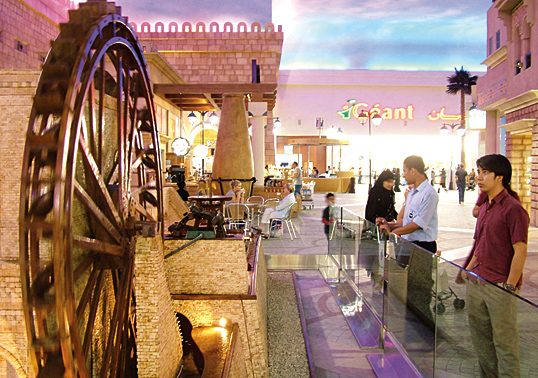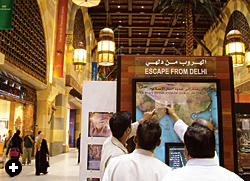
For students: We hope this two-page guide will help sharpen your reading skills and deepen your understanding of this issue’s articles.
For teachers: We encourage reproduction and adaptation of these ideas, freely and without further permission from Saudi Aramco World, by teachers at any level, whether working in a classroom or through home study.
— THE EDITORS
Class Activities
This issue’s Classroom Guide is organized around shopping. The Visual Analysis section is embedded.
Theme: Shopping
Shopping is a both a timeless necessity and, when prosperity allows, a pastime. People have always traded and shopped for things they need, like food, and for things they want—like iPods. Dubai’s business leaders surely recognize how many people like to shop: Dubai has an abundance of shopping malls, with even more in the planning stages. But shopping has had its place historically, too, as you will read in “East Meets West in Venice,” and it has a place today even in the less-developed parts of the world, as you will read in “New Nomads of the High Atlas.” In the activities that follow, you’ll have a chance to think about shopping—your own experiences and those that you’ll read about in Saudi Aramco World.

What kind of shopping experiences do you have?
Do you shop? Think about your own shopping experiences: What do you buy—groceries? clothes? music? books? Where do you shop? Do you enjoy shopping? Write a shopping journal. Be sure to address these topics:
- when you shop
- how often you shop
- what you shop for
- where you shop
- where the things you shop for have come from
- what the shopping experience is like for you
- details about a recent shopping excursion.
Keep your journal entry in mind as you work through the rest of the activities. It should help you think about shopping in other times and other places. Now turn your attention to the shopping enterprises described in Saudi Aramco World.
How does location affect shopping?
Find Venice and Dubai on a map. What is it about Venice’s location that made it a place where people shopped in the Middle Ages? What is it about Dubai’s location that makes it a place where people shop today? Of course, several centuries have passed since Venice was a shopping hub. What has changed in that time that has made Venice less of a shopping lure and Dubai more of one? “East Meets West in Venice” notes that ships carrying Christian pilgrims to the Holy Land often postponed leaving Venice so that travelers would shop more in the port city. Think about similar situations today. What kinds of places have “captive” shoppers—that is, people who, for some reason, are stuck someplace? How do sellers capitalize on these stuck people? (Hint: Up until the 1970’s, often the only things you could buy at airports were chewing gum and newspapers.) When you find yourself stuck in one of those places, do you ever shop for something you did not plan to buy?
What kinds of places do people go to to shop? How do shoppers behave in the different settings?
Team up with one or more people for shopping excursions. Your mission: Go to different kinds of shopping venues and observe consumer behavior. With your group, go to a supermarket, a clothing store at a mall, an outdoor shopping area such as a farmer’s market or street vendor, and a home computer. Watch how shoppers behave in each setting. What do you notice? Start with these questions, recording your findings for each place, and then come up with additional questions of your own: Do people use shopping lists? Do they spend a lot of time looking at things they might buy? Are people in groups, or alone? Do they talk? To whom? How old are the shoppers in each place? Are there more women than men? Try asking people about the following: (First explain that you’re working on a school project!) Are they shopping for something specific or “just looking”; what factors do they consider when deciding on a purchase; and so on. Make notes and prepare a presentation of your findings for the class. Based on the presentations, make a graphic that compares consumer behavior in different settings. How is that behavior similar across settings, and how is it different? Write a short summary that explains your findings.
What kind of shopping environments do different sellers create? Why?
Think about the Ibn Battuta Mall in “Edutaining Dubai.” Write your own description of the shopping environment there, based on the article’s descriptions and the photographs in the printed magazine and the Web edition. In your description, explain why the mall’s designers chose the Ibn Battuta theme. Discuss: How did Tim Mackintosh-Smith feel about the mall and its theme? How did his opinion change? Why did it change? What do you think about the mall’s theme? Why?
Imagine a mall with a theme based on another traveler or explorer. What about a Lewis and Clark mall, for example? Or a Sir Edmund Hillary mall? Or a Marco Polo mall? What would its “courts” be? What structural elements (e.g., columns, rivers, etc.) would it include? What objects? What people? Working with a group, design your own historically themed mall. Choose a theme person and identify at least five courts for your mall, as well as the structures, objects and people you would want represented there. Present your mall design to your class. Explain it. Include the historical references, and also how the design would encourage shoppers to buy things. After all, as Mackintosh-Smith reports, “The stuff—the goods, the shopping—comes first.”
Mackintosh-Smith uses the phrase “temporal and spatial slippage” when describing his experience at the Ibn Battuta mall. What do you think he means? Write a definition of the term based on how he uses it and what he says about it. Use the photos in “Edutaining Dubai” to explore the idea of temporal and spatial slippage. Choose any one of the photos to analyze. Without reading the caption, answer these questions about the photo: What is included? What different time periods are represented in it? What makes you think so? What different places are represented in it? What makes you think so? Write a caption for the photo as if you were Tim Mackintosh-Smith. Include one sentence that describes what’s in the photo, and then write at least two more sentences that relate the photo to the article’s analysis of the Ibn Battuta Mall. Compare your caption with another student’s.
Think about someplace you’ve been where temporal and/or spatial “slippage” happens. Take photographs of the place that show the slippage in a way that’s sim- ilar to the photos in “Edutaining Dubai.” Then write a caption for your photo, using the caption you wrote for Dick Doughty’s photo as a model.
How does shopping get integrated into settings whose primary purpose is not shopping?
These days it’s possible to shop in just about any setting, in all kinds of places that are not intended primarily as shopping venues. For example, you can visit an art museum and buy not only postcards and books with images of art, but all kinds of other items that are only vaguely connected to the museum. You can shop in hospitals, ballparks and even at religious shrines. In your day-to-day activities, pay attention to and list as many different “non-shopping” places where you can shop as you can. Pay attention, too, to places where you really can’t shop. List those, too. When you look at the two lists, try switching them around. For example, if you could, would you make it impossible to shop at a history museum? Or would you make it possible to shop at a funeral home? Write a fictional account of the place you’ve imagined.
 What kind of relationships do people develop and maintain in order to make shopping possible?
What kind of relationships do people develop and maintain in order to make shopping possible?
To shop at a mall, you don’t have to interact much with other people there. You have to be polite enough, but in general you can have minimal contact and still make your purchases. That’s not the case in every shopping environment, as you can read in “East Meets West in Venice” and “New Nomads of the High Atlas.” Both articles describe the kinds of relationships people develop to make commerce possible. (To be sure, the rock climbers described in “New Nomads” aren’t shopping the same way people shop at the mall in Dubai, but they are buying a service from the people of the Zawiya Ahansal region.) In both places, how does the need for buying and selling affect how people behave toward each other? Look at the photograph at the top of page 26. What do you see in it that suggests the kind of adaptations both the climbers and the local people have had to make in order to do business together?
Are there situations in which it’s better not to develop shopping relationships?
Shopping takes place within many contexts. One context, of course, is economic. But there are also political and ethical contexts within which we shop. How much do they affect us? Giandomenico Romanelli says that Venice’s traders ignored them completely: “The boundlessly cynical Venetians never let morality, religion or ideology get in the way of making money,” he said. Can you think of comparable situations today? Do some research to find out about the Fair Trade movement and the growth of organic products. Or research debates in your country about human rights and trade: Trade between the us and China is a good starting place. Learn about the situation. Then take a position for or against the morality of making economic gain more important than other considerations.
How well can people combine other activities with shopping?
The Ibn Battuta Mall is intended to provide shopping opportunities and also education. Circle the parts of the article that address the education element. How successful does Mackintosh-Smith think the mall is? How does he reach his conclusion? Look back at your own themed-mall design. What kinds of educational activities could you use to make your visitors’ shopping experiences educational as well as pleasing on a consumer level? Develop at least one such activity with your group. Have another group try doing it to see how well it works.
 |
Julie Weiss is an education consultant based in Lowell, Massachusetts. She holds a Ph.D. in American studies. Her company, Unlimited Horizons, develops social-studies, media-literacy and English as a Second Language curricula and produces textbook materials. |